#ralph s. singleton
Photo
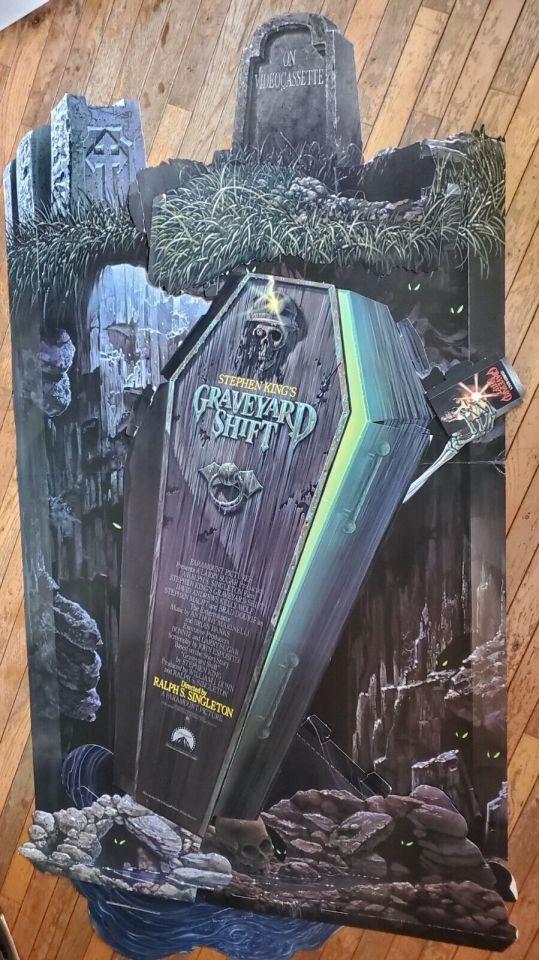
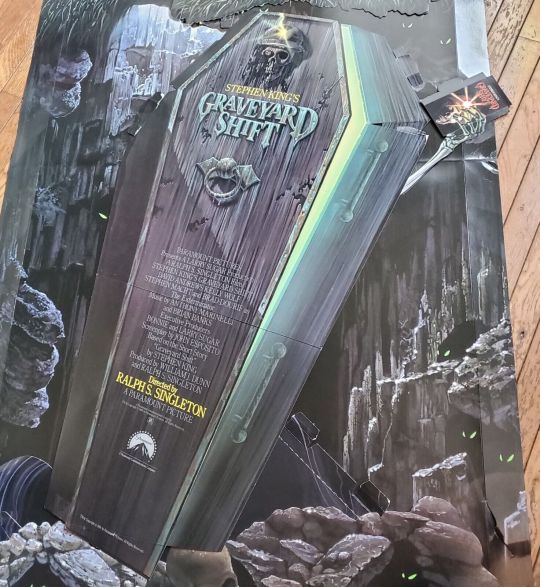
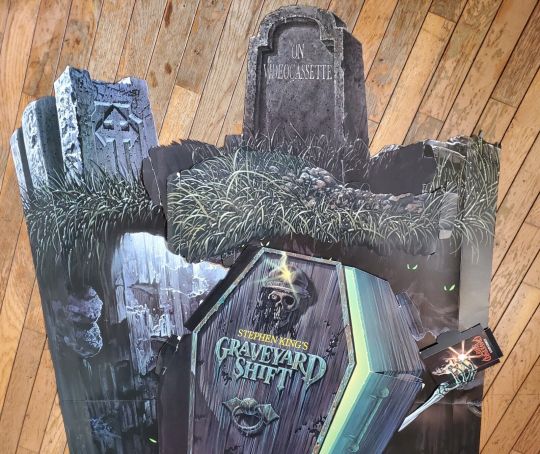
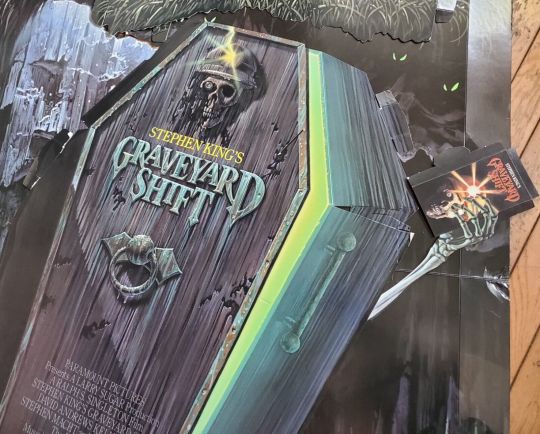
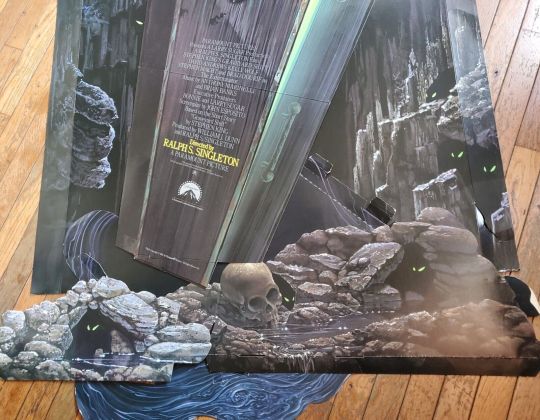

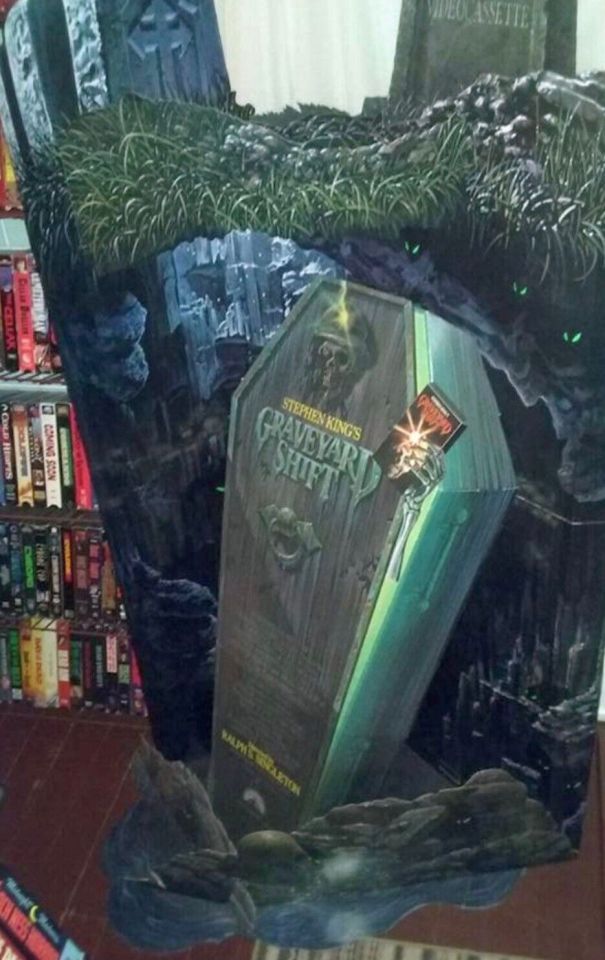
28 notes
·
View notes
Photo
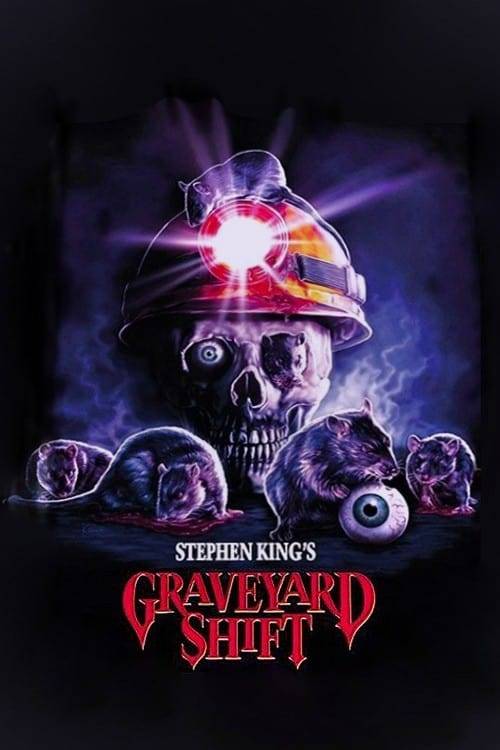
Movie #28 of 2023: Graveyard Shift
Tucker Cleveland: “I don't mind telling you, this place is infested.”
#graveyard shift#stephen king#horror#ralph s. singleton#john esposito#brian banks#anthony marinelli#peter stein#jim gross#randy jon morgan#35mm#english#1990#28
5 notes
·
View notes
Text
Watching Graveyard Shift directed by Ralph S. Singleton from 1990 on #max #NowWatching #FilmTwitter #FilmTumblr

0 notes
Text

#HARPERSMOVIECOLLECTION
2023
I watched Stephen King's Graveyard Shift (1990)
I recently watched another Stephen King adaptation, The Dead Zone, which is a rather good movie. So I wanted to go to the other end of the spectrum and watch a Stephen King adaptation that everyone seems to agree is terrible.
Workers cleaning out an old textile mill are plagued by rats and a creature living in the basement.
I go have a love for "terrible" Stephen King adaptations. I'm not talking about the Shining miniseries, which is an abomination. I'm talking about movies like this one or The Mangler or Sleepwalkers. The terrible ones are your typical shitty B-horror feel, but with a mild undercurrent of King's writing style, world building and unique dialogue. There's something about mediocre directors trying to capture what makes King's novels so engaging and failing at it that makes me so happy.
Director Ralph S. Singleton certainly isn't the one to capture that king magic. He overemphasizes certain moments in the wrong way in my opinion. Although, he does a fine job of making a flawed but fun little horror movie.
There's some gore, there's a monster, and there's enough here to make a "so bad it's good" flick that would be enjoyable with your friends.
I'll tell you who knows how to make a Stephen King character shine like the sun, and that's actor Brad Dourif. He's so good in this (and everything). And, he's clearly having fun and understanding his role. He, more than anything, makes this film worth a watch, and he's only a small part of it.
Stephen Macht is also having a lot of fun. His BIG maine accent is something to behold.
David Andrews' everyman protagonist character is probably the worst part to have in the film. Everyone around him is using up all the personality and he is boring. He's only fun when he's staring curiously at things. He stares a lot in this movie.
This movie is very clearly based on a short story. The basement of the textile mill is deeper than film's themes. In here somewhere there is something about bosses and the necessities of unions and regulation. I agree with that simple message.
The job which people are sent into the basement to do seems counter productive. They have to clean out old papers and furniture and things, while another guy soaks and blasts at rats with a fire hose. He's simultaneously making a huge mess while people try and clean. Maybe it'd work, but there must be better ways.
If you like Stephen King, you'll probably like this on some level. If the idea of a very simplistic 1990's horror about a small Maine town, working class Americans, rats and a monster sounds right up your alley, you'll probably like this.
It's not amazing by any means, but there's enough here for a bad movie night or if you're nostalgic for sitting at home on a Saturday afternoon watching random shit on cable.
The song over the final credits is a special treat.
0 notes
Text
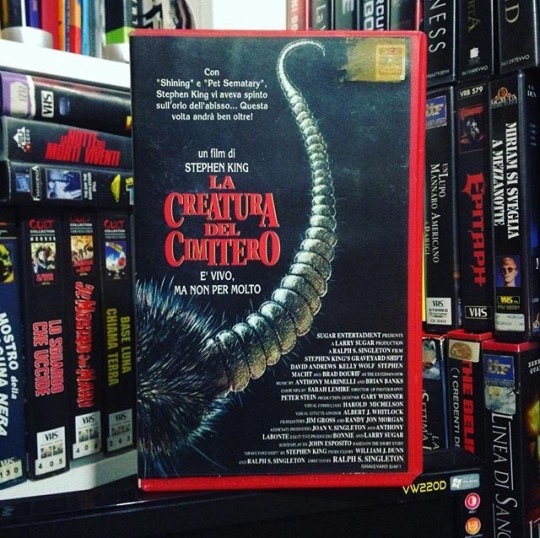
📼📼📼 Graveyard Shift - 1990 - Ralph S. Singleton 📼📼📼
#graveyard shift#brad dourif#ralph s. singleton#stephen king#vhs#vhs horror#horror#horror collection#horror movie#vhs collector#horror collector#sfx#cult#gore#monster#rat#graveyard#psycho#killer#slasher#splatter#nerd#nerdstuff#horror junkie
29 notes
·
View notes
Photo
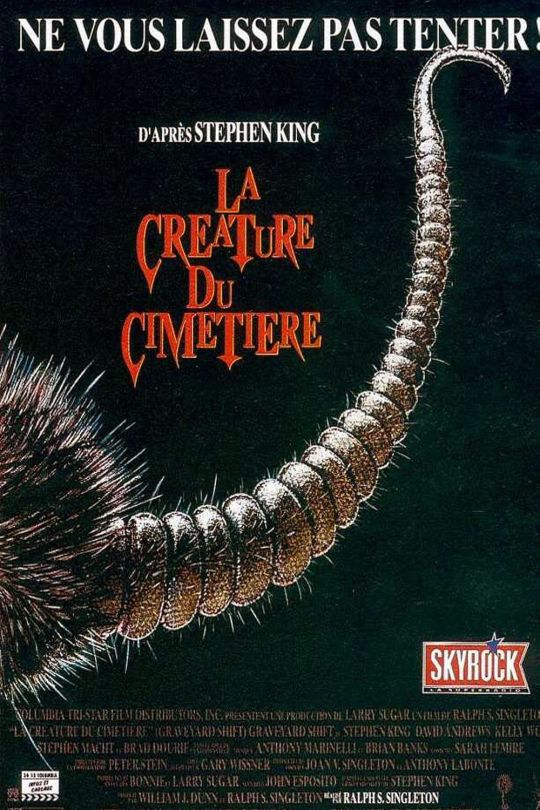
http://lemiroirdesfantomes.blogspot.com/2021/02/les-gaspards.html?view=magazine
0 notes
Photo

#247
Graveyard Shift - Ralph S. Singleton 1990
11 notes
·
View notes
Photo

Graveyard Shift (1990)
2 notes
·
View notes
Photo

From Book to Screen: Graveyard Shift
The Stephen King Book to Screen series takes its first dive into King’s short stories with GRAVEYARD SHIFT!
http://www.flickchart.com/blog/from-book-to-screen-graveyard-shift/
2 notes
·
View notes
Photo
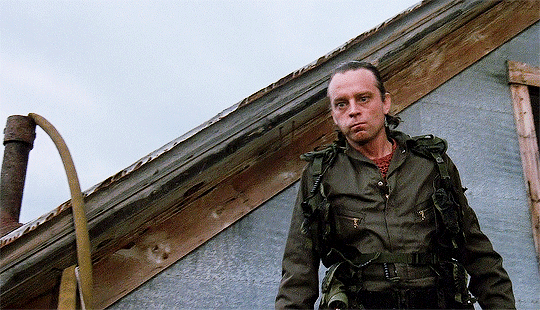
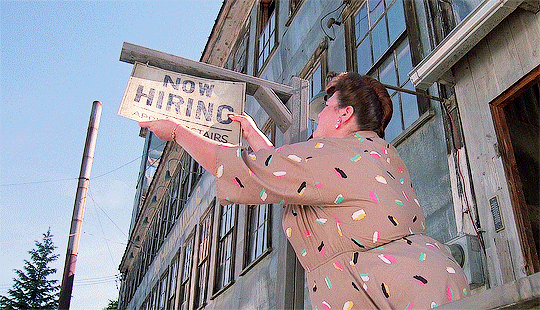
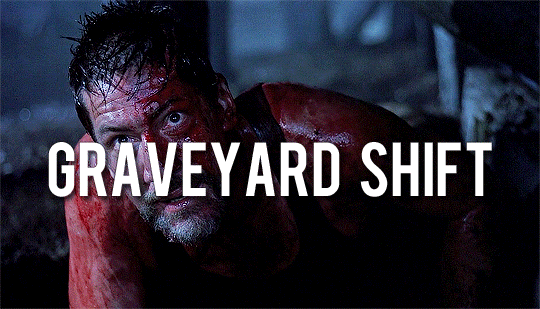
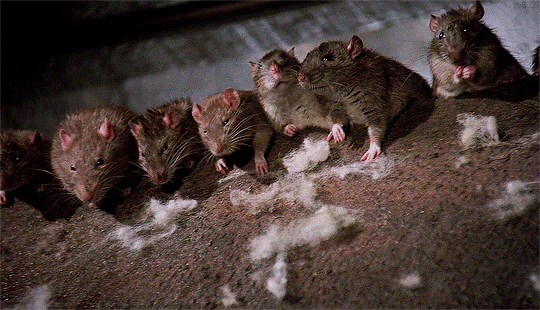
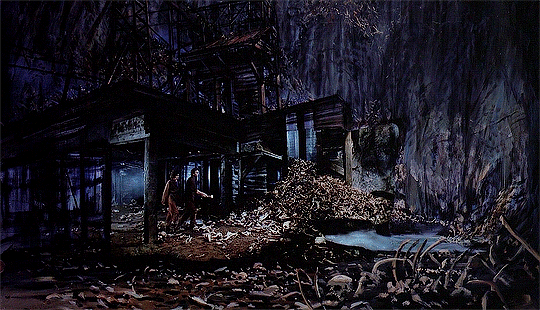
31 Days of Horror Marathon 2021
↪ Day 26: Graveyard Shift (1990) dir. Ralph S. Singleton
#graveyard shift#horroredit#31horror21#userhorroredits#filmedit#filmgifs#doyouevenfilm#fyeahmovies#moviegifs#cinemapix#dailyflicks#userrobin#userksusha#usergilli#userchaitali#userbritney#mikaeled#usergabrielle#usergina#chewieblog#kane52630#gifs#movie
439 notes
·
View notes
Text
The (Communal) History of System, Multiple, & Multiplicity
Introduction
In the fields of psychology and psychiatry, the terms system, multiple, and multiplicity have been used to describe DID/OSDD patients since the beginning of these disorders’ existence. In older academic papers, this kind of terminology was actually encouraged to describe DID/OSDD in particular, especially by Ralph B. Allison, Bennett G. Braun, and Richard Kluft, who helped pioneer this sort of language within dissociative research and treatment.
Despite that, it was most likely people with DID/OSDD who brought this clinical lingo to society’s awareness. The 1980’s to 2010’s saw many publications created by people with DID/OSDD, about DID/OSDD, and usually for other people with DID/OSDD. With the introduction of the world wide web, this verbiage only increased in popularity. While that may not seem very surprising, this provides valuable insight into the early dissociative community and how it evolved over time.
Early DID/OSDD Publications
During my deep dive, I stumbled across several early publications, such as newsletters, magazines, and books created by the early DID/OSDD community. The ones below seemed to be the most noteworthy because they were often mentioned in the archives I looked at. I will also be sharing an excerpt from each work to demonstrate what early community lingo was like.

When Rabbit Howls (1987): Truddi Chase’s “When Rabbit Howls” is an autobiography on her personal experiences with DID and surviving childhood abuse. This was one of the first few publications by a person with DID that did not push for unification (complete integration of all alters). You can find it on Amazon here.
(TW for abuse) p. 140
“When Putnam was researching schizophrenia, he discovered that the term didn’t fit all the patients he encountered. That led him to research the multiple personality cases recorded since the early 1800s. His final documented conclusion was that ninety-eight percent of the multiples on record involved repeated and severe incidents of child sexual and physical abuse. Incest seems to head the list, culprit-wise. For better or for worse, multiplicity may not be as rare as we think--only misdiagnosed..”

Many Voices (1989-2012): One of the oldest and longest running publications I could find was the DID/OSDD newsletter called Many Voices that ran from 1989 to 2012. This newsletter became such a hit that it eventually became a non-profit and is now owned by the ISSTD. According to the wishes of the founder of Many Voices, who has sadly passed away, the magazines are now freely available and you can read them here.
If you don’t mind discourse, I also highly recommend checking out @justanothersyscourse who occasionally shares memorable parts of the magazines.
What is a “true” multiple? (Many Voices, October 1989)
“I cringe when I hear people (therapists, clients, or lay-people) use the term ‘true’ multiple. What does that mean? If it means ‘SALS-She Ain’t Like Sybil,’ or ‘SALE-She Ain’t Like Eve’ (to quote the eminent Dr. Kluft,) then one could (and would) quite easily overlook or misdiagnose the majority of MPD patients. Again, to quote Dr. Kluft, only 3% to 4% of the MPD population flagrantly presents the symptoms of their MPD. The rest (if they’re even aware of being MPD) work very hard to hide it.
It is true that some multiples are more ‘split’ or separate than others. […] I believe that MPD lies on a continuum. The more severe and violent the abuse, […] the more separate and complex the system[…] Other factors which I feel influence the numbers of alters and the functionality of the system are 1) the personality or temperament of the family the MPD individual was born into and 2) the innate strength or weakness of each individual.”

Multiple Personality Gift (1991): While not a newsletter, a MPD/DID workbook called Multiple Personality Gift by Jacklyn Pia was published in September 1991. Back then, several diagnosed individuals choose to see their DID as a gift because it was what helped them survive childhood abuse. Jacklyn Pia, a ritual abuse survivor, described DID as a gift because they felt like it saved their life. You can read an archive of the book here.
Am I A Multiple? (Multiple Personality Gift, September 1991)
“Because a multiple has the presence of two or more distinct and recognizable personalities within, a variety of inside and outside happenings are present in his/her life that are not present in the lives of ‘singletons’ (a non-multiple person). […] In the following paragraph, are a number of inside and outside happenings commonly reported by people with the gift of multiplicity.”

Divided Hearts Newsletter (1996-?): Another older newsletter I found began publication in 1996 by a DID support website & forum called Divided Hearts. You can read the archived list here.
Some Facts about MPD/DID (Divided Hearts, September 1996)
“A multiple may have as few as two and as many as hundreds of personalities. The average number of alter personalities in a multiple is 8-13, although super-multiples may have more than 100 alternates.”

Collective Consciousness (?-1997) & Rainbow’s End (1998-Now): Collective Consciousness was a DID magazine but I’m unsure how long it ran for. I could not find much information on it. In July 1997, it ceased publication but was luckily picked back up by some folks who later formed the DID non-profit organization, First Person Plural. The new newsletter would be called “The First Person Plural Newsletter” up until 2002, when it was renamed to “Rainbow’s End.”
Rainbow’s End started in 1998 and is still running in present day. It’s freely available and you can read the magazines here.
A note on terminology (Rainbow End, April 1998)
“Multiplicity; Multiple Personality Disorder; Dissociative Identity Disorder; MPD; DID; DDNOS; Multie; Dissociator; Multiple Personality Gift; Host; Core; System; Alters; Parts; Ego States; Switching; Fusion; Integration; Out Front; Gone Deep; Co-conscious; In the background … etc etc
The language used to describe the dissociative experience is various and individualistic. First Person Plural retains the terms preferred by each contributor. Consequently throughout the newsletter different terms may be used for similar concepts.”

First Person Plural: My Life as a Multiple (1999): An autobiographical book written by Cameron West about his personal experiences with DID. You can look at the Wikipedia page for the book here. Cameron West’s website can also be found here. (I have not read the book so I can’t give any quotes but I think the title speaks for itself.)
Myths & Corroborating Evidence
Ever since I joined the dissociative community online, I have seen many, many myths floating around regarding these particular terms and their relation to dissociative disorders. The three myths I want to address are:
Myth #1 -- System, multiple, and multiplicity have no significance to the DID/OSDD community.
Myth #2 -- These terms were popularized by non-dissociative plurality groups (such as endogenic, natural, etc.) instead of the DID/OSDD community.
Myth #3 -- These terms were created by non-dissociative plurality groups.
Obviously, from the publications listed above (which is not an exhaustive list!), we know that myth #1 is just not true at all. Myth #2 & #3 can be fact-checked by this as well. The intermixing of DID/OSDD concepts with non-dissociative concepts emerged more in the late 1990s on the Internet, and it was certainly not very widespread at first. More information can be viewed here. And also here!
During my deep dive, I found that even the earliest online speakers on non-dissociative plurality, such as Astraea’s Web, have corroborated that system, multiple, and multiplicity originated from early DID/OSDD academia and publications. These publications can also be found all over archives of these earlier websites, too. Here are some archives that show that.
#there will be another post that covers the clinical history later#syscourse#actuallydid#actuallytraumagenic#dissociative identity disorder#actuallydissociative#abuse tw
127 notes
·
View notes
Photo

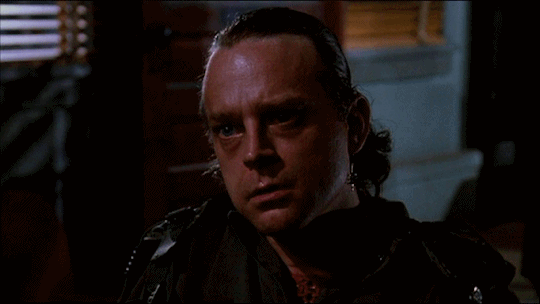
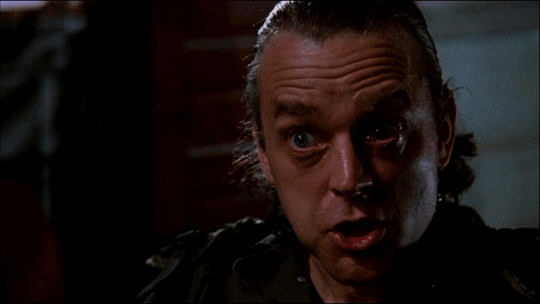
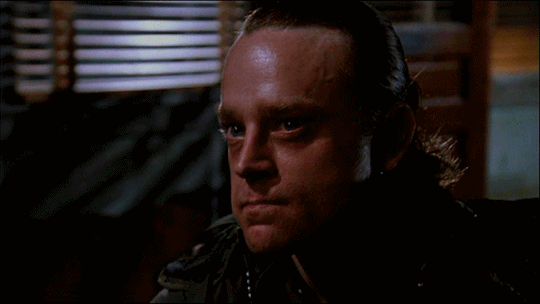

Brad Dourif as Tucker Cleveland in Graveyard Shift (1990) dir. Ralph S. Singleton
#brad dourif#tucker cleveland#graveyard shift#stephen king#horroredit#my edits#my gifs#braddourifedit#found a couple graveyard shift posts buried in my drafts#although I could of sworn I posted this one already
111 notes
·
View notes
Photo

Graveyard Shift (1990)
#1990s#actor jimmy woodard#dir ralph s singleton#dp peter stein#stephen king#cat horror#american#brown eyes#graveyard shift
4 notes
·
View notes
Photo
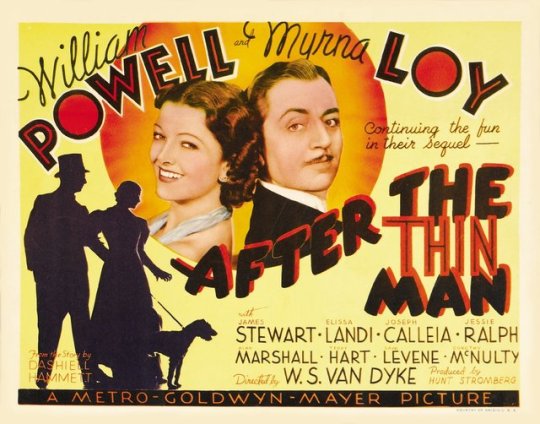
After the Thin Man
1936. Comedy
By W.S. Van Dyke
Starring: William Powell, Myrna Loy, James Stewart, Elissa Landi, Joseph Calleia, Jessie Ralph, Alan Marshal, Teddy Hart, Sam Levene, Penny Singleton, William Law, George Zucco, Paul Fix, Skippy the dog...
Country: United States
Language: English
#After the Thin Man#W.S. Van Dyke#William Powell#Myrna Loy#James Stewart#Elissa Landi#Joseph Calleia#Jessie Ralph#Alan Marshal#Teddy Hart#Sam Levene#Penny Singleton#William Law#George Zucco#Paul Fix#Skippy the dog#1936#30's#Comedy#United States#English#1930's
2 notes
·
View notes
Text
THE MARRIAGE LICENSE ERROR
January 21, 1949

“Marriage License Error” (aka “Marriage License”) is episode #27 of the radio series MY FAVORITE HUSBAND broadcast on January 21, 1949 over the Armed Forces Radio Network (AFN).
Synopsis ~ Liz and George find their marriage license and discover that instead of "George H. Cooper," it says "George C. Hooper." Now Liz is convinced that she and George aren't legally married!

Portions of this radio show served as the basis for “The Marriage License” (ILL S1;E26) filmed on February 28, 1952 and aired on April 7, 1952, on CBS-TV. On television, the Ricardo’s marriage license mistakenly read “Bicardi” instead of “Ricardo”.
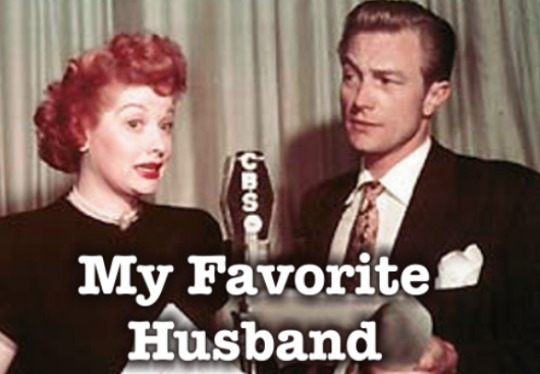
“My Favorite Husband” was based on the novels Mr. and Mrs. Cugat, the Record of a Happy Marriage (1940) and Outside Eden (1945) by Isabel Scott Rorick, which had previously been adapted into the film Are Husbands Necessary? (1942). “My Favorite Husband” was first broadcast as a one-time special on July 5, 1948. Lucille Ball and Lee Bowman played the characters of Liz and George Cugat, and a positive response to this broadcast convinced CBS to launch “My Favorite Husband” as a series. Bowman was not available Richard Denning was cast as George. On January 7, 1949, confusion with bandleader Xavier Cugat prompted a name change to Cooper. On this same episode Jell-O became its sponsor. A total of 124 episodes of the program aired from July 23, 1948 through March 31, 1951. After about ten episodes had been written, writers Fox and Davenport departed and three new writers took over – Bob Carroll, Jr., Madelyn Pugh, and head writer/producer Jess Oppenheimer. In March 1949 Gale Gordon took over the existing role of George’s boss, Rudolph Atterbury, and Bea Benadaret was added as his wife, Iris. CBS brought “My Favorite Husband” to television in 1953, starring Joan Caulfield and Barry Nelson as Liz and George Cooper. The television version ran two-and-a-half seasons, from September 1953 through December 1955, running concurrently with “I Love Lucy.” It was produced live at CBS Television City for most of its run, until switching to film for a truncated third season filmed (ironically) at Desilu and recasting Liz Cooper with Vanessa Brown.
REGULAR CAST
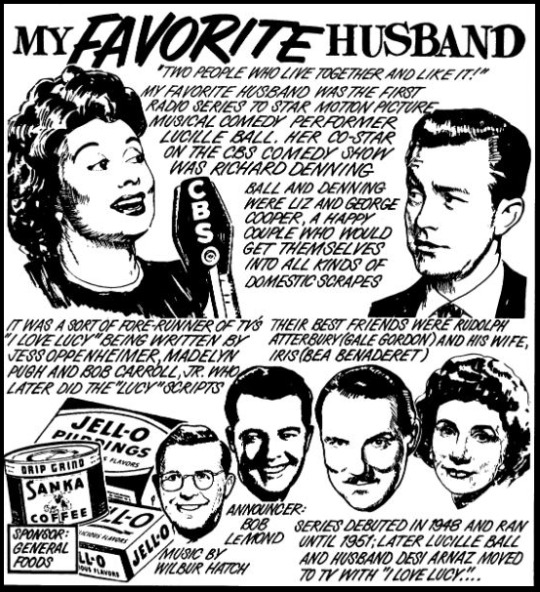
Lucille Ball (Liz Cooper) was born on August 6, 1911 in Jamestown, New York. She began her screen career in 1933 and was known in Hollywood as ‘Queen of the B’s’ due to her many appearances in ‘B’ movies. With Richard Denning, she starred in a radio program titled “My Favorite Husband” which eventually led to the creation of “I Love Lucy,” a television situation comedy in which she co-starred with her real-life husband, Latin bandleader Desi Arnaz. The program was phenomenally successful, allowing the couple to purchase what was once RKO Studios, re-naming it Desilu. When the show ended in 1960 (in an hour-long format known as “The Lucy-Desi Comedy Hour”) so did Lucy and Desi’s marriage. In 1962, hoping to keep Desilu financially solvent, Lucy returned to the sitcom format with “The Lucy Show,” which lasted six seasons. She followed that with a similar sitcom “Here’s Lucy” co-starring with her real-life children, Lucie and Desi Jr., as well as Gale Gordon, who had joined the cast of “The Lucy Show” during season two. Before her death in 1989, Lucy made one more attempt at a sitcom with “Life With Lucy,” also with Gordon.
Richard Denning (George Cooper) was born as Louis Albert Heindrich Denninger Jr., in Poughkeepsie, New York. When he was 18 months old, his family moved to Los Angeles. Plans called for him to take over his father’s garment manufacturing business, but he developed an interest in acting. Denning enlisted in the US Navy during World War II. He is best known for his roles in various science fiction and horror films of the 1950s. Although he teamed with Lucille Ball on radio in “My Favorite Husband,” the two never acted together on screen. While “I Love Lucy” was on the air, he was seen on another CBS TV series, “Mr. & Mrs. North.” From 1968 to 1980 he played the Governor on “Hawaii 5-0″, his final role. He died in 1998 at age 84.
Ruth Perrott (Katie, the Maid) was also later seen on “I Love Lucy.” She first played Mrs. Pomerantz (above right), a member of the surprise investigating committee for the Society Matrons League in “Pioneer Women” (ILL S1;E25), as one of the member of the Wednesday Afternoon Fine Arts League in “Lucy and Ethel Buy the Same Dress” (ILL S3;E3), and also played a nurse when “Lucy Goes to the Hospital” (ILL S2;E16). She died in 1996 at the age of 96.
Announcer Bob LeMond is not heard in this episode as it is part of the American Forces Network and has a different announcer.
Gale Gordon (Rudolph Atterbury) and Bea Benadaret (Iris Atterbury) had not yet joined the cast as regular characters.
GUEST CAST

Frank Nelson (Joe Ridgley) was born on May 6, 1911 (three months before Lucille Ball) in Colorado Springs, Colorado. He started working as a radio announcer at the age of 15. He later appeared on such popular radio shows as “The Great Gildersleeve,” “Burns and Allen,” and “Fibber McGee & Molly”. This is one of his 11 performances on “My Favorite Husband.” On “I Love Lucy” he holds the distinction of being the only actor to play two recurring roles: Freddie Fillmore and Ralph Ramsey, as well as six one-off characters, including the frazzled train conductor in “The Great Train Robbery” (ILL S5;E5), a character he repeated on “The Lucy Show.” Aside from Lucille Ball, Nelson is perhaps most associated with Jack Benny and was a fifteen-year regular on his radio and television programs.

Doris Singleton (Hotel Biltmore Telephone Operator) created the role of Caroline Appleby on “I Love Lucy,” although she was known as Lillian Appleby in the first of her ten appearances. She made two appearances on “The Lucy Show.” Singleton played a secretary in the first episode of “Here’s Lucy” and was meant to be a series regular, but her role was written out to concentrate on Lucy Carter’s family life. She did two more episodes of the series.
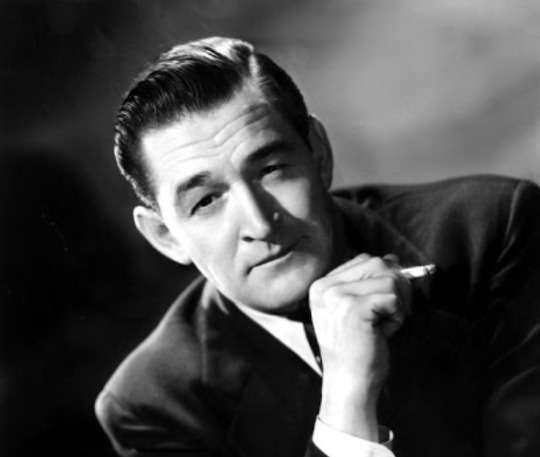
Ted de Corsia (Police Officer) was an actor in touring companies and on radio before making a memorable film debut as the killer in The Lady from Shanghai (1947). De Corsia's New York street demeanor and gravelly voice assured him steady work playing street thugs, gang leaders or organized-crime bosses. On radio he starred in the CBS series "Pursuit" (1949-50). Two years after this episode of “My Favorite Husband,” he appeared with Lucille Ball on the radio show “The Golden Touch.”
The actor voicing the role of Paul Buchanan is not credited and has not been identified.
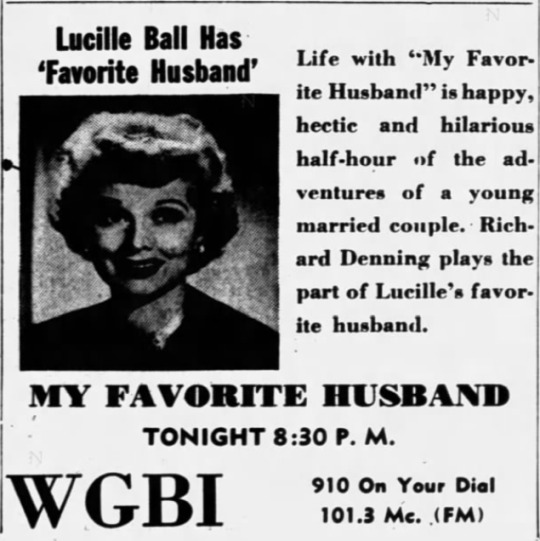
EPISODE
The Coopers are spending the evening in the living room reading the newspapers. Liz is doing the crossword puzzle, while George scans the headlines.
GEORGE: “Well, it looks like the inauguration came off alright.”
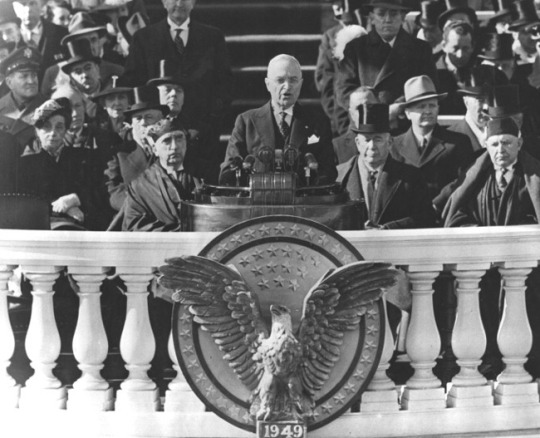
George is referring to the second inauguration of incumbent President Harry S. Truman, which happened in Washington DC the previous day. It ushered in Truman’s second term in office. It was the first televised U.S. presidential inauguration and the first with an air parade.
Liz insists that crosswords build her vocabulary. George quizzes her on current events.
GEORGE: “Where did the President take his oath of office?”
LIZ: “On a special platform built in front of the capitol building.
GEORGE: “How did you happen to know that?”
LIZ: “It showed through the hole when I cut out the crossword puzzle.”
GEORGE: “Try this: who administered the oath?”
LIZ: “What?”

The familiar trope of husbands being engrossed in the morning papers to the dismay of their wives takes a slightly different spin here, but was continued well into “I Love Lucy.” The answer that George is looking for is that Chief Justice Fred M. Vinson administered the presidential oath of office that day in 1949.
Through the hole, Liz recognizes the name of Paul Buchanan, who is in the paper because he was elected president at the jewelers convention. Liz recalls dating him in high school. He played tuba in the school band. Liz says she might have married but for his tuba playing.
Liz says that if she had married Paul she might have gotten an engagement ring. Instead, George couldn’t afford a ring and gave her a sweat shirt with his initials on it. George says the initials actually stood for Gym Class!
LIZ: “I was lovely! I was engaged! I was dressed like Maxie Rosenbloom!”
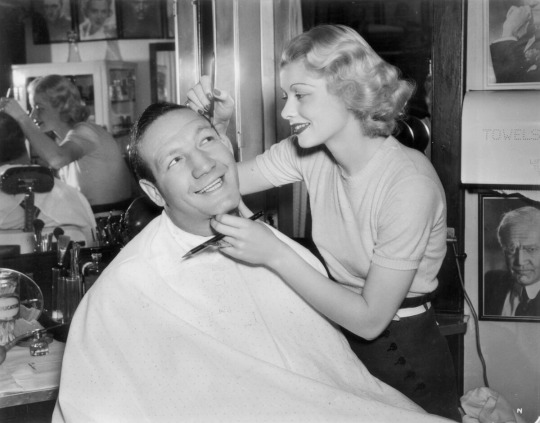
Max Everitt Rosenbloom (1907-76) was a professional boxer, actor, and television personality. In 1948 he played a truck driver in the Paulette Goddard film Hazard. Nicknamed “Slapsie Maxie”, he had appeared in the film Muss ‘Em Up (1936) in which a blonde Lucille Ball was a background performer. She posed with him for the above publicity shot, helping him apply his make-up!
Liz senses that George is still upset about the ring, so she sits on his lap and they cuddle and kiss. Liz opens their scrapbook, looking at their wedding photos. She sees her marriage license.
LIZ: “On this date, Elizabeth Elliott was married to George C. Hooper!”
Liz panics thinking that their license may be invalid - and they might not even be legally married! As soon as the Sheridan Falls City Hall opens, Liz intends to go down there personally and find out for sure!
Unbeknownst to Liz, George calls his friend at the license bureau, Joe Ridgley (Frank Nelson). He tells Joe that he wants him to play a joke on Liz, and tell her that they are not really married! Joe agrees.
Liz arrives at the bureau and explains to Mr. Ridgley about the error. He tells Liz that it does indeed matter. He refers to her as “Miss Elliott” and confirms that she hasn’t been married to George for ten years!
Liz returns home. When George goes to kiss her - she says that she is no longer his to touch!
LIZ: “The man at the license bureau put the padlock on our wedlock.”
Liz insists they go right down to the license bureau and get re-married. George - having some fun at her expense - hesitates. Liz is as upset as she is angry! Just then, Katie the Maid takes Liz aside into the kitchen to tell her that it’s all a joke between George and Joe. Liz decides to get revenge for his prank.
Liz goes back into the living room and George suddenly confesses to his joke - but when he describes Joe Ridgley, Liz says that he is not describing the man she spoke to at all! Which means that they really aren’t married after all! George wants to go right down to City Hall and re-marry, but Liz (teasing him along even further) says not so fast - she wants to be single a little longer!
Liz picks up the phone to call Paul Buchanan to ask him out on a date. She reminds him that she was called “Queen of the Rumble Seat”!
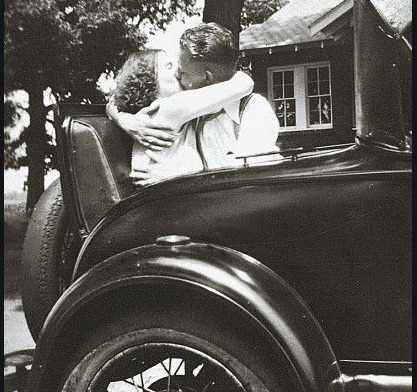
A rumble seat was an additional padded passenger seat that popped up from the rear of the vehicle, usually just big enough for two. This led it to becoming synonymous with romantic trysts!
Liz knows that George can’t hear Paul on the other end as he protests that he is married with six kids! He abruptly hangs up, but Liz continues her staged phone conversation with the hotel operator (Doris Singleton). Liz says that she will meet him at the Flamingo Room of the Biltmore.
In the kitchen, Liz tells Katie that while George thinks she is on a date with Paul Buchanan at the Biltmore, she and Katie will actually be watching Humphrey Bogart at the Strand movie theater.

In January 1949, Bogart’s most recent film would have been Key Largo, released in mid-summer 1948. It went on to win an Oscar for Claire Trevor. Humphrey Bogart never appeared on screen with Lucille Ball. However, in “Ricky’s Movie Offer” (ILL S4;E5) Desi Arnaz does an impression of Bogart and in “Lucy and the Andrews Sisters” (HL S2;E6) Lucy blows a kiss to a large poster of Bogart from the movie Casablanca.
Coming out of the Strand later that evening, Liz and Katie notice a crowd in front of the Biltmore Hotel. Katie thinks it might be a wreck!
LIZ: “When you see a crowd in front of a window these days, it isn’t a wreck, it’s television!”
KATIE: “Oh, well maybe they’re showing a wrestling match!”
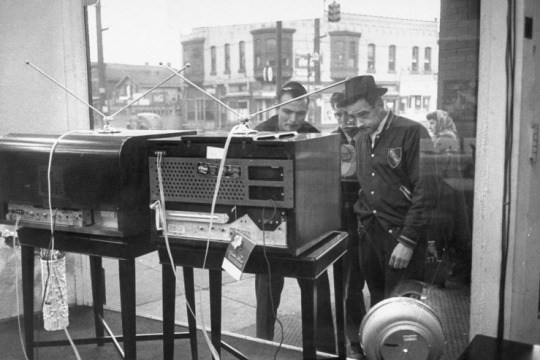
Before television sets became affordable to the general public, it was not uncommon to find people gathered on the sidewalk in front of a store window to view it from the street.
LIZ: “Katie it is wrestling! There’s gorgeous George!”
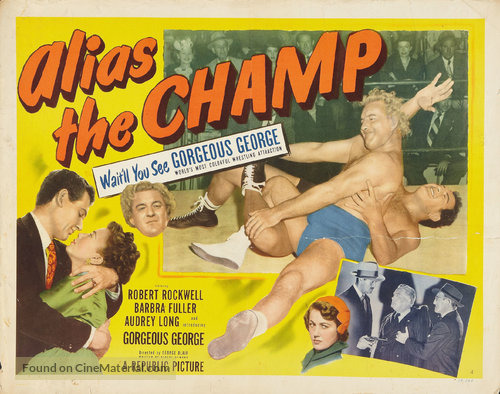
Liz is referring to her husband, George but wrestling matches were very popular on early television, producing such colorful wrestlers as Gorgeous George. George Raymond Wagner (1915–63), was known as Gorgeous George because of his long blonde hair. He was mentioned on “I Love Lucy” in “Pioneer Women” (ILL S1;E25) and “Ricky’s Movie Offer” (ILL S4;E6). In 1949, Republic Pictures released a film starring Gorgeous George.
A Policeman (Ted de Corsia) is breaking up a brawl between George Cooper and Paul Buchanan. Paul is nothing like Liz remembered: bald, fat and with a black eye. Paul remembers George from school. Liz is delighted having two men fighting over her. George spots Liz in the crowd. When George insists Liz is his wife, Liz claims she never saw him before.
When the cop wants to arrest George, Liz pretends to be from Brooklyn (Myrtle Avenue) to talk him out of it. She insists that George buy her an engagement ring (from Paul) to get out of going to jail. The office gladly agrees - if George will properly propose on one knee first! Liz insists he use her ‘pet’ name.
GEORGE: “Will you marry me... toodly-woodly-ums!”
COP: “When you gonna get married?”
LIZ: “Ten years ago!”
COP: “Why that’s impossible!”
LIZ: “Who cares! I’ve got back my favorite husband!”
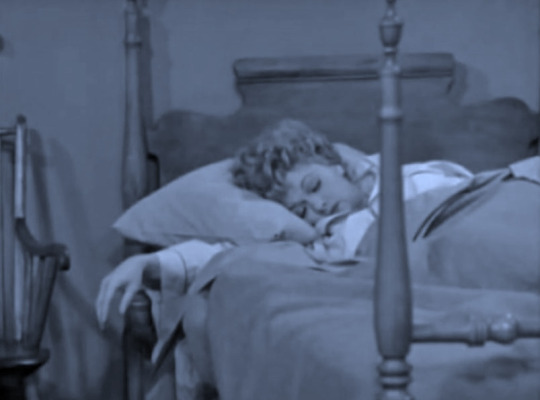
In the bedtime tag, Liz asks George to get up and get her a glass of warm milk. After bickering about it for a moment, George reluctantly agrees, stubbing his toe on the chair. By the time he finds his slippers, Liz is snoring, fast asleep.
GEORGE: “How do you like that? Goodnight, Liz.”
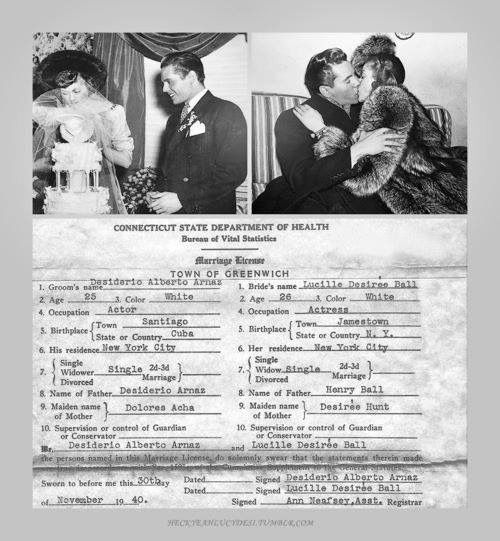
#Marriage License#My Favorite Husband#I Love Lucy#Lucille Ball#Richard Denning#Frank Nelson#Ruth Perrott#CBS Radio#Doris Singleton#Tony Di Corsia#keychain#Humphrey Bogart#Gorgeous George#Maxie Rosenbloom#TV#Harry S. Truman#Rumble Seat#1949
2 notes
·
View notes
Photo

Graveyard Shift will be released on Blu-ray on July 28 via Scream Factory. The 1990 horror film is based on Stephen King's short story of the same name, which was first published in 1970 and later collected in 1978's Night Shift.
Ralph S. Singleton (Cagney & Lacey) makes his lone feature directing effort from a script by John Esposito (The Theatre Bizarre). David Andrews, Stephen Macht, Kelly Wolf, Andrew Divoff, and Brad Dourif star.
Extras are in progress and will be announced at a later date.
When an abandoned textile mill is reopened, several employees meet mysterious deaths. The link between the killings is the hour: all occurred between 11 p.m. and 7 a.m. – the Graveyard Shift. The sadistic mill foreman has chosen a group to clean up the mill’s rat-infested basement. But what the workers find is a subterranean maze of tunnels leading to the cemetery – and an unimaginable horror that comes alive in the dead of night...
#graveyard shift#stephen king#scream factory#stephen macht#brad dourif#david andrews#dvd#gift#andrew divoff#horror#1990s hororr#90s horror#paramount#horror movies#horror film
28 notes
·
View notes